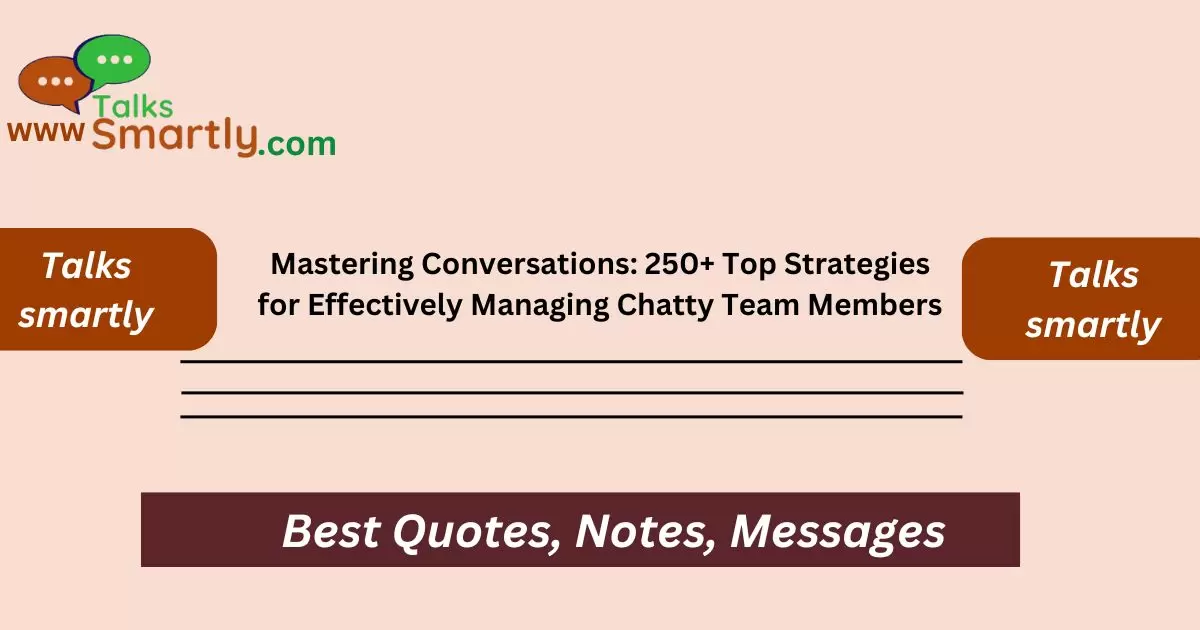Managing chatty team members can be challenging, but with the right strategies, you can turn this potential distraction into a productive asset. Here’s how you can master the art of conversation control.
Dealing with chatty team members is a common challenge in any workplace. While open communication is essential, balancing it with productivity can be tricky. When conversations become frequent or lengthy, they can disrupt workflows and affect team morale.
To address this issue, it’s crucial to have effective strategies at your disposal. This article will provide over 250 actionable tips to help you manage conversations with talkative colleagues, ensuring that discussions remain productive and focused.
By applying these strategies, you’ll improve communication dynamics and enhance overall team efficiency. These insights will help you foster a more controlled and productive work environment, making sure that everyone stays on track and aligned with their goals.
Setting Clear Boundaries
- Define specific times for meetings and discussions.
- Use visual cues like “Do Not Disturb” signs to indicate focus times.
- Establish guidelines for when and where conversations are appropriate.
- Communicate the impact of excessive talking on productivity.
- Encourage the use of agendas to keep meetings on track.
- Implement time limits for individual speaking turns.
- Provide training on effective communication practices.
- Create a schedule that includes dedicated times for social interactions.
- Use office layout to minimize distractions.
- Remind team members of deadlines and priorities regularly.
- Offer feedback on how conversations affect team performance.
- Set up a signal system to indicate when discussions need to end.
- Reward adherence to communication guidelines.
- Use written communication for complex topics.
- Allow time for social breaks but limit their duration.
- Schedule one-on-one meetings for in-depth discussions.
- Implement a “talking stick” policy during group conversations.
Promoting Active Listening
- Train team members in active listening techniques.
- Encourage summarizing and repeating back information.
- Use questioning techniques to guide the conversation.
- Acknowledge the speaker’s points before offering your own.
- Create a culture where everyone’s voice is heard.
- Set up listening exercises and workshops.
- Provide feedback on listening skills regularly.
- Use structured feedback forms to capture key points.
- Encourage taking notes during conversations.
- Implement regular check-ins to gauge understanding.
- Use body language to show attentiveness.
- Develop guidelines for respectful interruptions.
- Promote empathy in interactions to enhance understanding.
- Reward team members who demonstrate strong listening skills.
- Use clear and concise language to facilitate understanding.
- Create a “listening corner” for quiet reflection.
- Encourage feedback on the quality of team communications.
Implementing Time Management Tools
- Introduce digital timers for meetings and discussions.
- Use project management tools to allocate time for tasks.
- Implement calendar reminders for scheduled breaks.
- Set up time-tracking software to monitor conversation lengths.
- Allocate specific times for team updates and casual chats.
- Use time-blocking techniques to organize the workday.
- Encourage using productivity apps to manage personal time.
- Provide training on time management best practices.

- Set deadlines for discussion topics during meetings.
Creative Ways to Ask “How Do You Feel About Me”
Encouraging Structured Conversations
- Create an agenda for every meeting.
- Use bullet points to outline discussion topics.
- Assign a facilitator to guide conversations.
- Implement a “round-robin” approach to ensure equal participation.
- Use timed agenda items to keep discussions focused.
- Encourage use of a “parking lot” for off-topic ideas.
- Assign a note-taker to capture key points and decisions.
- Implement a “two-minute rule” for speaking times.
- Provide clear action items and next steps after each discussion.
- Set up regular check-ins to follow up on action items.
- Use project management tools to track progress on discussion topics.
- Encourage the use of decision-making frameworks.
- Establish clear objectives for each conversation.
- Use feedback loops to assess meeting effectiveness.
- Introduce a “wrap-up” process for each meeting.
- Offer training on effective meeting management skills.
- Use follow-up emails to recap important points and decisions.
Creating a Positive Team Environment
- Foster an inclusive atmosphere where everyone feels valued.
- Encourage open and respectful communication.
- Promote team-building activities to enhance rapport.
- Recognize and celebrate team achievements.
- Provide constructive feedback in a supportive manner.
- Create a space for informal conversations to build relationships.
- Encourage collaboration and mutual support.
- Develop clear communication norms and expectations.
- Offer regular recognition for effective communication.
- Implement conflict resolution strategies when needed.
- Promote transparency and honesty in discussions.
- Provide opportunities for professional development in communication.
- Encourage feedback on team dynamics and communication.
- Create a supportive environment for new ideas and suggestions.
- Develop team rituals that support positive interactions.
- Encourage flexibility and adaptability in communication styles.
- Provide resources for managing stress and maintaining well-being.
Handling Interruptions Effectively
- Set guidelines for when interruptions are appropriate.
- Use hand signals or visual cues to manage interruptions.
- Train team members on polite interruption techniques.
- Encourage waiting for a pause before interjecting.
- Establish a protocol for handling urgent versus non-urgent interruptions.
- Use a “pause” button in meetings to manage interruptions.
- Provide feedback on the impact of interruptions on productivity.
- Implement a “talking stick” method to control who speaks.
- Encourage note-taking instead of immediate interruptions.
- Use meeting agendas to minimize unplanned interruptions.
- Foster a culture of respect for speaking turns.
- Train team members on managing their own interruptions.
- Create a “question time” at the end of meetings.
- Use technology tools to manage and prioritize interruptions.
- Provide clear instructions on how to handle side conversations.
- Regularly review and adjust interruption management strategies.
- Offer support for team members struggling with interruption control.
Using Technology Wisely
- Use video conferencing tools to manage remote discussions.
- Implement collaboration software to keep conversations on topic.
- Use chat applications to organize discussions by topic.
- Set up email filters to manage communication flow.
- Use project management tools to track discussion outcomes.
- Implement scheduling apps to manage meeting times.
- Utilize online polls for decision-making in discussions.
- Provide training on using digital communication tools effectively.
- Encourage the use of shared documents for collaborative work.
- Set up notification management to reduce digital distractions.
- Use data analytics to assess communication patterns.
- Implement security measures to protect sensitive discussions.
- Use virtual whiteboards for brainstorming sessions.
- Integrate communication tools with project management systems.
- Provide resources for managing digital communication overload.
- Offer guidance on best practices for digital communication.
- Regularly review technology use to ensure effectiveness.
Developing Effective Feedback Mechanisms
- Implement regular feedback sessions to discuss communication.
- Use anonymous surveys to gather honest feedback.
- Provide constructive feedback on communication styles.
- Encourage peer-to-peer feedback for continuous improvement.
- Use feedback to adjust communication strategies and policies.
- Set up a system for tracking feedback and improvements.
- Offer training on giving and receiving feedback effectively.
- Develop feedback forms for specific communication aspects.
- Use feedback to recognize and reward effective communicators.
- Implement a feedback loop to address recurring issues.
- Provide clear guidelines for providing actionable feedback.
- Create opportunities for informal feedback discussions.
- Regularly review feedback to identify trends and areas for improvement.
- Encourage open dialogue about feedback practices.
- Offer support for team members who need improvement.
- Use feedback to enhance team cohesion and productivity.
- Provide resources for developing feedback skills.
Balancing Social and Work Conversations
- Establish clear times for social interactions and work tasks.
- Set guidelines for when social conversations are appropriate.
- Encourage quick social interactions during breaks.
- Use structured breaks to manage social time.
- Create designated spaces for casual conversations.
- Implement a “work time” versus “social time” policy.
- Promote efficient use of break times to maintain productivity.
- Encourage team-building activities outside of work hours.
- Use social interactions as a reward for achieving goals.
- Provide training on balancing work and social interactions.
- Implement systems to track time spent on social versus work tasks.
- Create a culture that values both work and social engagement.
- Set clear expectations for social behavior in the workplace.
- Offer flexible work schedules to accommodate social needs.
- Use structured team events to manage social time.
- Encourage setting personal boundaries for social interactions.
- Provide guidance on managing social time effectively.
Managing Remote and Hybrid Teams
- Use video conferencing tools to maintain team cohesion.
- Implement regular virtual check-ins to monitor progress.
- Set clear expectations for virtual communication.
- Encourage use of chat and collaboration tools for remote discussions.
- Create guidelines for managing remote team conversations.
- Use shared digital workspaces to keep track of discussions.
- Promote virtual team-building activities to enhance relationships.
- Provide training on effective remote communication practices.
- Set up clear protocols for virtual meeting participation.
- Use project management software to track remote work progress.
- Regularly review remote team communication effectiveness.
- Encourage feedback from remote team members on communication.
- Implement strategies to address time zone differences.
- Use digital tools to manage and prioritize tasks.

- Provide support for remote team members to ensure effective communication.
- Foster a culture of inclusivity in remote team interactions.
- Ensure remote team members feel engaged and valued.
Addressing Communication Barriers
- Identify common barriers to effective communication.
- Provide training on overcoming communication challenges.
- Implement strategies to address language and cultural differences.
- Use clear and simple language to enhance understanding.
- Encourage feedback to identify and address communication barriers.
- Set up support systems for team members with communication difficulties.
- Use visual aids to assist in conveying information.
- Offer resources for developing communication skills.
- Create a supportive environment for addressing communication issues.
- Provide training on non-verbal communication cues.
- Use technology to assist with communication needs.
- Foster a culture of openness and inclusivity.
- Implement regular reviews to assess communication barriers.
- Offer one-on-one support for team members facing challenges.
- Provide feedback on overcoming specific communication barriers.
- Encourage team members to share their communication needs and preferences.
- Use structured processes to address and resolve communication issues.
Cultivating Leadership and Facilitation Skills
- Provide training on leadership and facilitation techniques.
- Encourage leaders to model effective communication behaviors.
- Set up mentoring programs to develop communication skills.
- Implement leadership workshops focused on managing conversations.
- Offer feedback on leadership communication effectiveness.
- Create opportunities for leaders to practice facilitation skills.
- Develop guidelines for effective leadership communication.
- Use role-playing exercises to improve facilitation techniques.
- Provide resources for ongoing leadership development.
- Encourage leaders to seek feedback on their communication style.
- Set up regular reviews to assess leadership communication skills.
- Promote a culture of continuous improvement in leadership.
- Offer support for leaders to address communication challenges.
- Use case studies to highlight successful communication strategies.
- Develop leadership programs focused on managing team dynamics.
- Encourage leaders to share best practices for effective communication.
- Provide tools and resources for enhancing leadership communication.
Answer to key question
1. How can I manage a chatty team member without seeming rude?
- Set clear communication boundaries, use polite reminders, and provide feedback constructively.
2. What are some effective tools for managing time during conversations?
- Use timers, project management apps, and structured meeting agendas.
3. How can I balance social and work conversations effectively?
- Establish dedicated times for each, set guidelines for social interactions, and use structured breaks.
4. What strategies work best for managing remote team conversations?
- Use video conferencing, clear virtual communication protocols, and regular check-ins.
5. How can I address communication barriers in a diverse team?
- Provide training, use clear language, and implement support systems for language and cultural differences.
Conclusion
Managing chatty team members is crucial for maintaining a productive work environment. By implementing these strategies, you can ensure that conversations are effective and contribute positively to team goals. Clear communication, structured processes, and supportive leadership are key to balancing open dialogue with productivity.
Applying these tips will help you navigate the challenges of managing team conversations, creating a more focused and cohesive team environment. Remember, effective communication is about balance and understanding, and with these strategies, you can achieve both.












